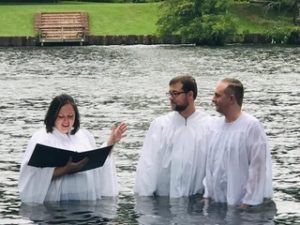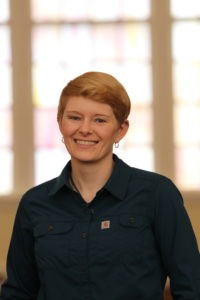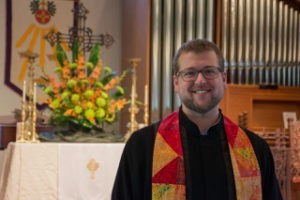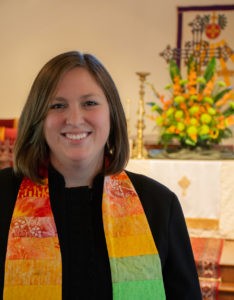After graduating seminary together in 2015, Claire and Zach Helton were told their chances of leading the same church as a couple were slim, at best.
“You want to be co-pastors?” the couple recalled being asked by a placement specialist. “That’s the unicorn of church jobs. It’s rare.”

Claire Helton and husband Zach, center, conduct a Baptism.
Rare, maybe, but not impossible. The couple this month celebrates one year as co-pastors at Northminster Church, an Alliance of Baptists congregation in Monroe, Louisiana.
They and other pastor teams interviewed by Baptist News Global say the arrangement saves wear and tear on bodies, minds and spirits as preaching, pastoral visits and difficult decisions are shared between equals.
The approach also benefits church members by doubling the ministerial support available to them and promoting a collaborative decision-making process especially helpful in challenging situations, the ministers said.
‘Clarity about boundaries’
Even so, it’s valid to describe the co-pastoring model as the unicorn of ministry jobs, said Mark Tidsworth, a church consultant and president of Pinnacle Leadership Associates.
“The pure co-pastor arrangement is pretty rare,” he said. “I don’t run into it very often.”
When he does, it’s usually a husband-wife team in which one member of the couple has a greater share of responsibility than the other. It works best if the power is truly shared by clergy who are embraced as equals by the congregation, he said.
Of the co-pastor teams interviewed by BNG, only the Heltons are a couple. But they, like the others, expressed the importance of consistent, clear communication to make it work.
Tidsworth said that is a common trait among successful co-pastor pairings.
“It requires fairly mature people who are committed to the model and who have excellent communication skills and really want to see it through,” Tidsworth said.
The model has certain strengths, including an allowance for the sharing of greater insights and perspectives in shepherding congregations.
Difficulties can result if authority and responsibility are poorly articulated or understood.
“So, there has to be clarity about boundaries and limitations,” Tidsworth said. “It also requires the church to exercise excellent communication and understanding when working through things.”
‘Someone who balances you’
Having someone to shoulder responsibilities has helped Brett Harris and Kathryn Kimmel manage both daily routines and major challenges at University Baptist Church in Hattiesburg, Mississippi.

Brett Harris
The two-minister team was able to double outreach efforts in the aftermath of federal raids of Mississippi food-processing plants over the summer that resulted in the arrest of hundreds of immigrants.
While facilities targeted by ICE were not located in Hattiesburg, Harris and Kimmel tapped their individual networks to get financial and material aid flowing to those working directly with the immigrant families.
Harris said he and Kimmel, who also is known as “Kat,” were much more effective as co-pastors.
“Kat and I have had conversations with each other and with other pastors across the state,” he said.
It sends a powerful message to the congregation, Harris added.

Kathryn Kimmel
“There’s something very powerful about seeing both male and female leadership in the church,” he added. “The co-pastor model allows a lot of ideas on the table without everything being up to a single person.”
The arrangement also helps in working through the everyday tasks of church leadership, she said. It also enables them to learn from their partner’s strengths.
“To have someone who balances you and broadens your thinking and opens your eyes, it’s really powerful,” she said.
‘It breaks down hierarchy’
The effectiveness of co-pastoring lies in spreading power and in fostering a cooperative spirit in ministry, said Melanie Vaughn-West, pastor for worship, pastoral care and administration at Oakhurst Baptist Church in Decatur, Georgia.

Melanie Vaughn-West
While not using the “co-pastor” title, Vaughn-West shares pastoral leadership with Lauren Colwell, pastor for Christian education and community engagement.
“We like the model because it breaks down hierarchy, reduces isolation and allows a pastor to have a fully equal partner,” Vaughn-West said.
The duo shares in leadership responsibilities, including decision making, at Oakhurst, Colwell said.
“But in terms of daily and weekly responsibilities, those are separated out,” Colwell explained.
This approach to pastoral leadership has permeated the congregation, where committees have given way to ministry teams in which leadership is shared. Vaughn-West and Colwell include other ministry and lay staff in their planning sessions.
A significant benefit is never having to go it alone on difficult decisions.

Lauren Colwell
“On your own, you don’t always have the best answer or solution,” Vaughn-West said. “Having someone to talk and pray and meditate with is extremely helpful.”
Both women said the team concept at Oakhurst helps maintain and boost energy for whatever comes their way.
“You come in expecting to be supported and encouraged,” Colwell said. “You don’t come in thinking how am I going to convince everyone to do what I want them to do?”
The system contributes to longevity in ministry.
“This approach to ministry could benefit a lot of pastors out there who are close to burnout and isolation,” Vaughn-West said.
‘Spread the gospel of co-pastoring’

Zach Helton
Claire and Zach Helton say “amen” to that.
Sharing preaching responsibilities by itself is a huge weight off each of them.
“We preach every other week,” Claire said.

Claire Helton
Zach said he recently joked with another pastor about it.
“I said ‘I don’t know how you preach every week – no one should have to preach every week. How do you come up ideas?’”
Being able to divide tasks “by what gives us life” goes a long way to prevent burnout, Claire said.
“We’re very happy to spread the gospel of co-pastoring,” she said.
